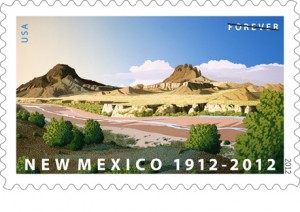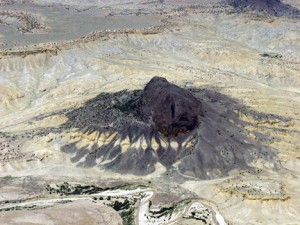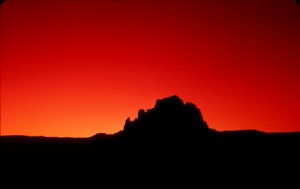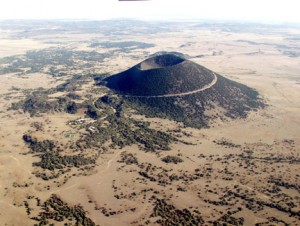By Dr. Frances Levine, Director, New Mexico History Museum/Palace of the Governors
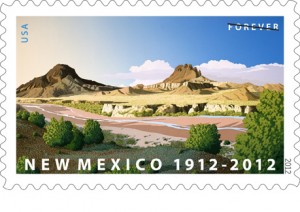 This morning, January 6, the New Mexico History Museum/Palace of the Governors will host a First-Day-of-Issue event on behalf of the U.S. Postal Service and its New Mexico Centennial stamp. That we’re kicking off a year of Centennial activities at the History Museum with a stamp-related event delights my historian sensibilities by inviting New Mexico’s citizens to take part in a letter-writing project.
This morning, January 6, the New Mexico History Museum/Palace of the Governors will host a First-Day-of-Issue event on behalf of the U.S. Postal Service and its New Mexico Centennial stamp. That we’re kicking off a year of Centennial activities at the History Museum with a stamp-related event delights my historian sensibilities by inviting New Mexico’s citizens to take part in a letter-writing project.
To tell the stories of our past, historians gather information from many sources. They use photographs, documents, and artifacts, like the 47-star flag now on display downstairs in the New Mexico History Museum. But what they treasure more than anything are journals and letters – written accounts of what was happening just as it was happening and told by participants in the events.
As we prepared to mark the Centennial in our exhibitions with an installation called 47 Stars, we discovered that the historians who preceded us had left out some of the accounts we would have loved to use. That got us wondering about what we’re leaving for the people who will one day mark New Mexico’s 200th year as a state.
These days, hand-written accounts of our lives are in short supply. We all rely on e-mails to communicate, but I bet few of us print them out and save them in a box under the bed. Many of us mark the mileposts of our lives with short Facebook updates that go – where? Who knows?
Some historians say all this electronic communication will provide a bounty of material for future historians. Others say something will be sorely missing, that holding a letter written by a person who participated in the historic events as they happened and reading the thoughts they considered important enough to put on paper is truly what makes people connect across generations and throughout history.
Lew Wallace finished writing the novel Ben Hur while he was a Territorial governor in New Mexico, and he left this account of what it was like to work on the book inside the Palace of the Governor’s thick adobe walls.
My custom when night came was to lock the doors and bolt the windows of the office proper, and with a student’s lamp, bury myself in the four soundless walls of the forbidding annex. Once there, at my rough pine table, the Count of Monte Cristo in his dungeon of stone was not more lost to the world.
The ghosts, if they were ever about, did not disturb me; yet in the hush of that gloomy harborage, I beheld the Crucifixion, and strove to write what I beheld.
I can feel the surface of his rough pine table. I can imagine the chill of a supposed ghost when a viga creaked or loose page fell to the floor. Those are special details to historians and help us bring the past to life.
Each of us has a gift to leave for tomorrow’s historians: A written account of our lives today. So all of us at the New Mexico History Museum have a radical proposal: Write us a letter. That’s it. Just a letter. Tell us a bit about what your life in the year 2012 is like.
Update: The letter need not be hand-written if you’d rather print it out.
Describe your house, your neighborhood, the businesses you like to visit and why. What games do you play? Where do you go to enjoy the outdoors and what does it look like today? What kind of job do you have and what’s the status of that industry? What do you worry about? What gives you hope? What is it about New Mexico that makes it your home place and heart place?
Fold it up, put it in an envelope, address it, and then mail it – maybe using one of those beautiful Centennial stamps. We’ll collect them and share them throughout the year but, most important, we’ll put them into a safe place to spend a few decades gaining perspective. When 2112 rolls around, New Mexico’s historians will delight in the treasure trove you helped create.
Send your letters to: Centennial Letter Writing Project, New Mexico History Museum, 113 Lincoln Ave., Santa Fe, NM, 87501.

